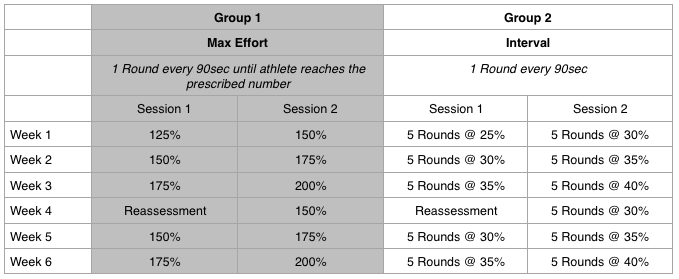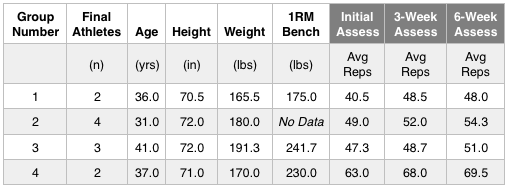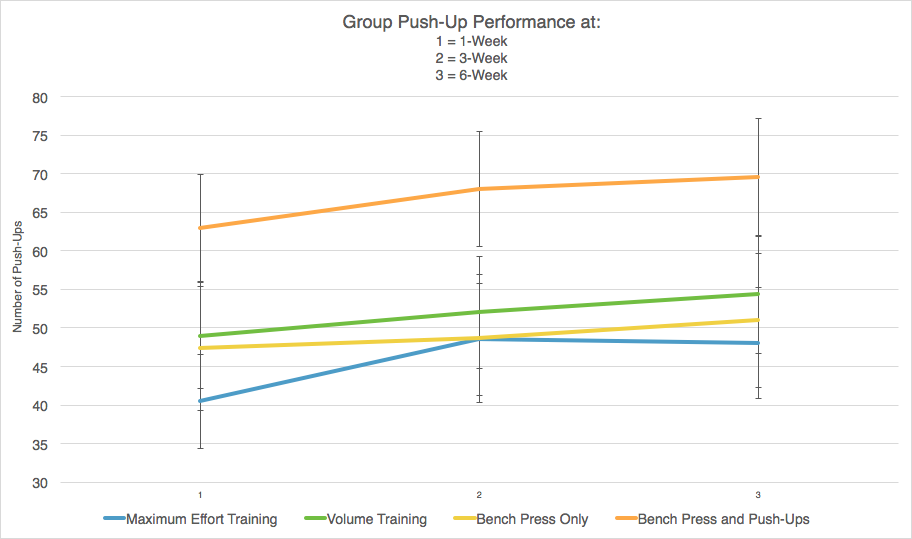
Adam Scott, MS, CSCS
Push-Ups are abounded not only in tactical but also in the fitness world. They are used in fitness tests (1,2). They are used during training programs (3,4). And they are even used to predict injuries and job performance (4).
So, we set out to examine four commonly used methods for improving Push-Ups. Here is what we found…
QUICK REVIEW
We began the pilot program back in mid-December (Article #1). The study design was based on our previous work investigating Pull-Ups (Best Way to Improve Pull-Ups).
Basically, we took the four push-up training programs and randomly split our lab rats among them (see TABLE 1 for details). Then, for six weeks our athletes completed their assigned push-up training as part of their daily training session.
TABLE 1: Push-Up Training Programs by Group


RESULTS: As you can see in TABLE 2, we lost quite a few athletes over the course of the study. Overall we dropped from 17 participants to 10. The hardest hit group was Group 1, the Maximum Effort Training Group.
TABLE 2: Athlete Attrition by Group

Regrettably, our lower numbers means that none of our between-group comparisons were statistically significant. Without statistical significance, basically, we do not know if our results are a product of group training differences or just random chance. So, for what its worth, TABLE 3 shows how the four groups compare. At the far right of the table, you will see that groups’ averages during their three assessments.

Looking at the data, we see that all three groups showed improvement during the first three weeks. However, it is important not to be too misled by this quick adaptation. Changes like this are almost universally accepted to be the result of short-lived neurological adaptations and familiarity with movements (12,13). This seems supported by the fact that the two group which solely trained push-ups improved the quickest – in other words, they just got used to doing push-ups.
Contraryto the quick neurological gains experienced during early training, it is usually around 5-6 weeks when we start to see real, lasting strength changes in the musculoskeletal system (12,13). Looking at GRAPH 1 we can see the changes by group at each assessment.

Like previously stated all between-group comparison should be viewed with plenty of skepticism due to the small sample sizes. For this reason, I don’t want to spend too much time examining them. However, a couple of things stand-out in this graph.– First is that fact that, statistically, there was no difference between the four groups – all four improved at roughly the same rate (8-18%).- Another interesting finding was that the group which improved the most (Group 1) did so only during the first 3 weeks. The group’s performance then decreased during the last 3 weeks (-0.5 reps). This might be a product of the training’s inability to transfer quick neurological gains into enduring strength adaptations.
– Lastly, the group with the least amount of improvement was Group 3, the Bench Press only group. However, this group was also the oldest, tallest, heaviest, and strongest at the beginning of the study. This undoubtedly affected their results – as you will see below.
Moving on, the last thing we wanted to examine was how anthropometric measures like height and weight might effected performance changes. While there is very little research into specific training regimes there are plenty of studies looking at how these measures relate to push-up ability.
For this analysis, we lumped all the participants together into one group and examined the data set as a whole.
TABLE 4 displays a correlation matrix of the demographic statistics we collected for each group. To read the table, follow the row to the corresponding column which you want to examine. For example, the first row contains the correlations for the initial push-up score and all the other measures. Row 2 contains the correlations for age and the remaining characteristics…and so on.

What really stands-out in this matrix are the relationships associated with 1RM bench press (strength) and weight.– First, higher 1RMs were significantly correlated to higher initial push-up performance. However, higher 1RMs were also negatively correlated with improvements in push-up performance. Basically, the stronger the athlete, the less they improved. Also, the taller and heavier an athlete, the less they improved.- Second, an athlete’s initial score seemed to have little or no effect on their push-up performance change (seen in the top, right-most cell).
– Third, the results outlined in TABLE 4 also seem to support previous findings which show that health-related anthropometric variables (like height, weight, etc.) are most predictive of push-up performance (3).
– Finally, looking at the correlations between 1RM bench presses and push-up scores, our data seems to support some of the previous research which shows that push-up performance and body mass can be used to predict 1RM bench press (5,6).

CONCLUSIONS
- Not surprisingly, it seems like doing push-ups is a necessary training component, if for no other reason than to simply build the neurological familiarity with the exercise. However, careful consideration should be given to ensuring that those gains become enduring strength gains.
- Based on our small study it seems that at least three of the four training programs could be effective (Max Effort, Interval, and Bench Press plus Interval). We would probably recommend staying away from the Bench Press Only training program.
- Heavier and taller athletes are likely going to have more trouble improving their push-up performance in a short, six-week study.
- High 1RM bench press strength is highly correlated to initial push-up performance. However, that higher level of strength seems to be a liability when trying to make improvements in a short amount of time.
Lastly, looking ahead, one possible way to expand the study would be to examine push-up variants. This could include the use of plyometrics, tempos and even hand position variations. Earlier studies have shown these to be useful alternatives (8,9,10).
NEXT STEPS
For us, the next step is to take this design and find a larger group to test what we learned. So, if you have access to a group of 30-40 lab rats (we would like 8-10 per group) and are interested in helping us examine this topic further, please let us know.
Question, Comments, Feedback? Email coach@mtntactical.com
You Might Also Like MTI’s Push Up Improvement Packet
References:
- Knapik, J, Sharp, M, Canham, M, Patton, F and Jones, B. Risk factors for training-related injuries among men and women in basic combat training. Med Sci Sport Ex.: 33(6):946-954. 2001.
- Michaelides, M, Parpa, K, Henry, L, Thompson, G and Brown, B. Assessment of physical fitness aspects and their relationship to firefighter job abilities. J of Strgth Con Res.; 25(4):956-965. 2011.
- Esco, M, Olson, M and Willford, H. Relationship of Push-Ups and Sit-Ups Tests to selected anthropometric variables and performance results: A multiple regression study. J of Strgth Con Res.; 22(6):1862-1868. 2008.
- Crawley, A, Sherman, R, Crawley, W and Cosio-Lima, L. Physical fitness of police academy cadets: Baseline characteristics and changes during a 16-week academy. J of Strgth Con Res.; Post Acceptance. 2015.
- Rana, S, Guenther, E, Bullard, S and Gilders, R. Prediction of one repetition maximum bench press from push-ups in college-aged females. J of Strgth Con Res.; 2011.
- Mayhem, J, Ball, T, Arnold, M and Bowen, J. Push-ups as a measure of upper body strength. J of Strgth Con Res.; 5(1). 1991.
- Ebben, W, Wurm, B, VanderZander, T, Spadavecchia, M, Durocher, J, Bickham, C and Petushek, E. Kinetic analysis of several variations of push-ups. J of Strgth Con Res.; 25(10):2891-2984. 2011.
- Vossen, J, Kramer, J, Burke, D, and Vossen, D. Comparison of dynamic push-up training and plyometric push-up training on upper-body power and strength. J of Strgth Con Res.; 14(3):248-253. 2000.
- Gouvali, M, Boudolos, K. Dynamic and electromyographical analysis in variants of push-up exercise. J of Strgth Con Res.; 19(1):146-151. 2005.
- Invergo, J, Ball, T and Looney, M. Relationship of push-ups and absolute muscular endurance to bench press strength. J of App Sport Sci Res; 5(3):121-125. 1991.
- LaChance, P and Hortobagyi, T. Influence of cadence on muscular performance during push-up and pull-up exercise. J of Strgth Con Res.; 8(2):76-79. 1994.
- Folland, J, Williams, A. The adaptations to strength training : morphological and neurological contributions to increased strength. Sports Med.; 37(2):145-68. 2007.
- Baechle, E and Earle, R. Essentials of Strength Training and Conditioning – 3rd Edition. NSCA -National Strength & Conditioning Association. Copyright 2008
